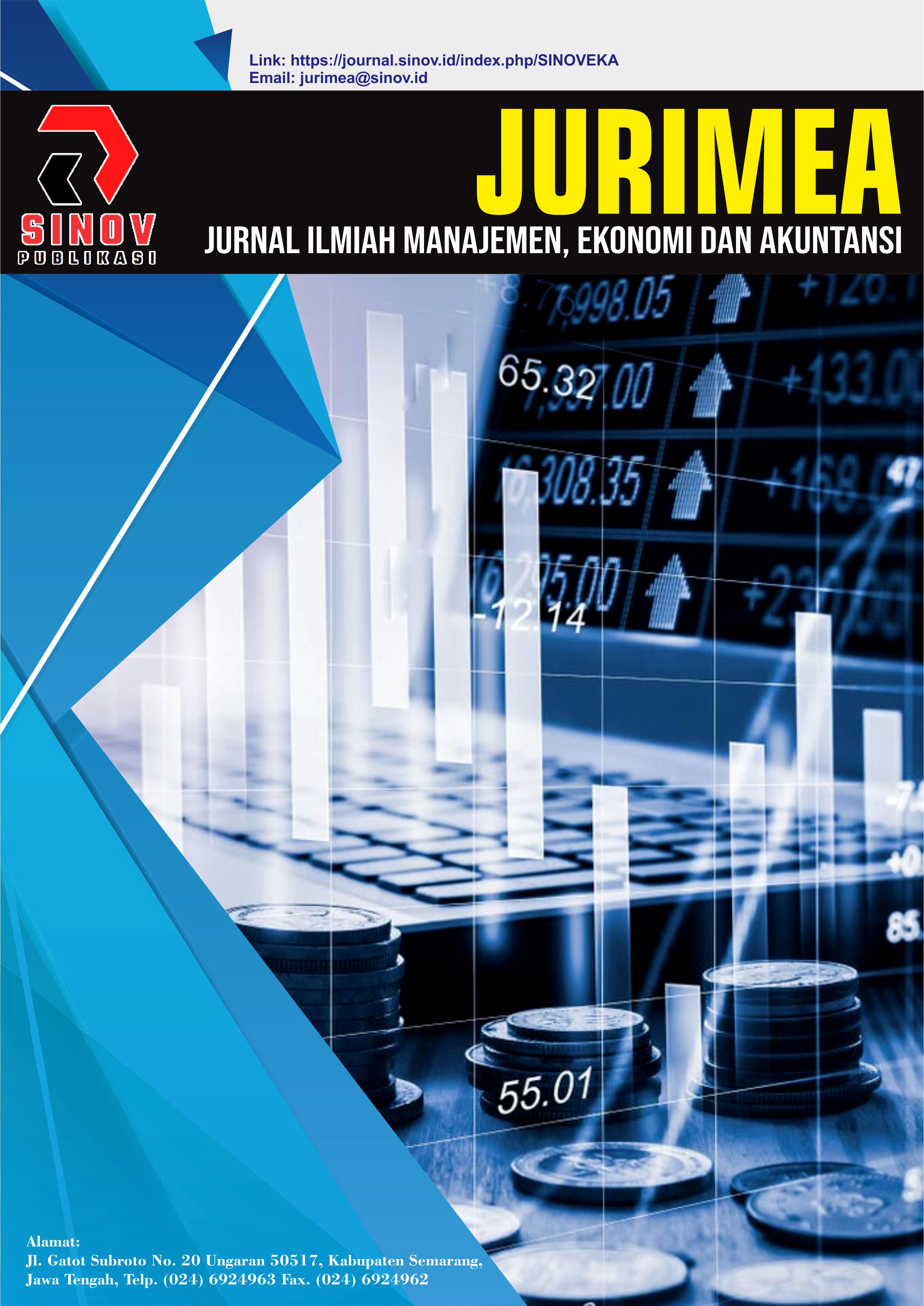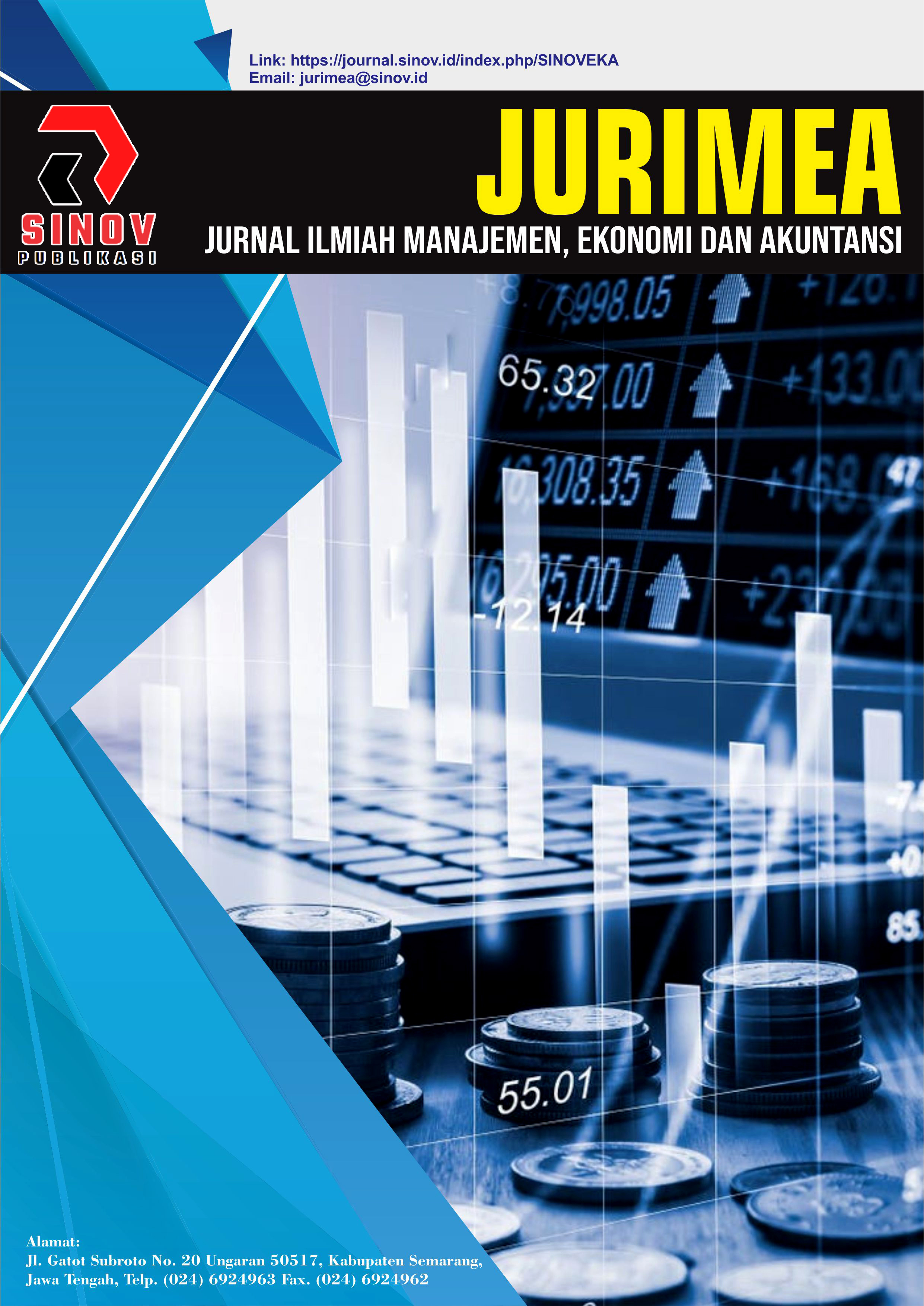Implementasi Digital Banking di Kawasan Asia Tenggara
DOI:
https://doi.org/10.55606/jurimea.v5i2.1140Keywords:
Internet, Digital Banking, Southeast AsiaAbstract
The increase in digital banking due to the influence of high levels of internet usage makes the process of digital financial services easy. The Internet is growing rapidly, fast and cheap, has the potential to increase productivity and competitiveness of Southeast Asian economies. The study was conducted in 10 Southeast Asian countries, namely Indonesia, Malaysia, the Philippines, Singapore, Thailand, Brunei Darussalam, Myanmar, Vietnam, Laos, and Cambodia. Except for Timor Leste due to limited data in supporting this research. The object of this study is the use of digital banking as a dependent variable, while the exchange rate (Nt), foreign exchange reserves (Cd), and interest rate (Sb) are independent variables. In addition, the amount of money in circulation is M0 & M1 as the moderator variable. The data collection technique is by taking panel data from 2014 – 2023 obtained from the official website, namely Stastika.com, Tranding Economic, Focus Economic, World bank and sources related to this research. The data collection technique in this study was carried out using Eviews12. tests are needed in selecting the most appropriate estimates, namely, the Chow Test, the Hausman Test and the Lagrange Multiplier Test. In the regression of moderation variables using the Moderated Regression Analysis (MRA) interaction model.
References
Aprillia, A., Syahfia, N., Putri, W. F., Nasution, D. P., & Rusiadi, R. (2024). Stabilitas Sistem Keuangan dan Pertumbuhan Ekonomi Melalui Kebijakan Makroprudensial di 5 Negara ASEAN. Jurnal Ilmiah Global Education, 5(1), 264–279. https://doi.org/10.55681/jige.v5i1.2136
Asnah & Sari, Dyana, Pengantar Ilmu Ekonomi Makro (Pengantar Ekonomi Makro) (16 Februari 2021). PENGANTAR ILMU EKONOMI MAKRO ISBN 9786230-228834, 2021, Tersedia di SSRN: https://ssrn.com/abstract=3786438
Avirutha, A. A. (2021). ASEAN in digital economy: Opportunities and challenges. Journal of ASEAN plus Studies, 2(1), 17–25.
Curott, N. A. (2012). Adam Smith’s Theory of Money and Banking. Ball State University. Retrieved from SRRN https://papers.ssrn.com/sol3/papers.cfm?abstract_id=2136133
Dienillah, A. A., & Anggraeni, L. (2016). DAMPAK INKLUSI KEUANGAN TERHADAP STABILITAS SISTEM KEUANGAN DI ASIA. Buletin Ekonomi Moneter Dan Perbankan, 18(4), 409–430. https://doi.org/10.21098/bemp.v18i4.574
Olilingo, F, Z. (2023). Ekonomi Internasional (Cet. I). Yogyakarta: Deepublish.
Gunadi, I., Taruna, A. A., & Harun, C. A. (2013). Penggunaan indeks stabilitas sistem keuangan (ISSK) dalam pelaksanaan surveilans makroprudensial. WP BI No, 15.
HAKIZIMANA, S., Makau Charity Wairimu, M.-, & Stephen, M. (2023). Digital Banking Transformation and Performance-Where Do We Stand? International Journal of Management Research and Emerging Sciences, 13(1). https://doi.org/10.56536/ijmres.v13i1.404
Harahap, B. A., Idham, B., Cinditya, A., Kusuma, M., & Rakhman, R. N. (2017). PERKEMBANGAN FINANCIAL TECHNOLOGY TERKAIT CENTRAL BANK DIGITAL CURRENCY (CBDC) TERHADAP TRANSMISI KEBIJAKAN MONETER DAN MAKROEKONOMI. Bank Indonesia
’Istiqomah, N., ’Mafruhah, I., ’Muntiyas, H., “Rahmanasari,” H., & ’Saputra, A. (2023). Pengantar Ekonomi Makro (I. Mutianingtyas, Ed.; Cetakan Pertama). Jejak Pustaka.
Jurnal, W., Saleha, B., Efendi, B., Pembangunan, E., & Kata Kunci, A. (2024). Analisis akseptansi sistem pembayaran digital dan inklusi keuangan dalam mendorong pertumbuhan ekonomi nasional di 5 negara ASEAN. Indonesian Research Journal on Education, 4(1), 1-15. https://irje.org/index.php/irje
Kholis, N., Program, D., Manajemen, S., Dewantara, S., Raya, J., & Bojong, P. (2018). Perbankan dalam era baru digital. Jurnal Ekonomi dan Bisnis, 12(1), 80-88.
Martineli, I. (2021). Menilik Financial Technology Dalam Bidang Perbankan. Jurnal Somasi Sosial Humaniora Komunikasi, 2(1), 32–43.
Mulyana, R., Achsani, N. A., Andati, T., Nur, T., Maulana, A., & Pratama, A. Y. (2022). Karya ini berlisensi di bawah Creative Commons Attribution 4.0 (CC BY 4.0) Estimasi Efisiensi Teknis Perbankan Indonesia Berbasis Stochastic Frontier Analysis. Technomedia Journal (TMJ), 7(2), 2528–6544. https://doi.org/10.33050/tmj.v7i2
Mutiasari, A. I. (2020a). Perkembangan industri perbankan di era digital. Jurnal Ekonomi Bisnis Dan Kewirausahaan, 9(2), 32–41.
Rahmah, L. P. (2018). Analisis hubungan independensi bank sentral dan variabel makroekonomi terhadap stabilitas sistem keuangan di ASEAN (Tesis Sarjana). Universitas Brawijaya.
Pradipta, Y., Abdullah, A., & Suhendi. (2023). Seizing Opportunities: The Race Toward Digital Banking in ASEAN (pp. 343–353). https://doi.org/10.2991/978-94-6463-144-9_34
Puspitasari, N. D. (2023). Pengaruh kebijakan moneter bank sentral terhadap kinerja keuangan bank umum. Jurnal Cendekia Keuangan, 2(1), 42-54. https://doi.org/10.32503/jck.v2i1.3381
Rusdianasari, F. (2018). The Role of Financial Inclusion through Fintech Integration in the Financial Stability Indonesian. Jurnal Ekonomi Kuantitatif Terapan, 11(2), 244–253.
Sattar. (2017). Buku ajar ekonomi internasional (N. Subekti, Ed.; Cetakan Pertama). Deepublish. Yogyakarta.
Suprihanto. (2023). Pengantar Ekonomi Makro. PT Kreasi Skrip Dijital.Jakarta
Tangiduk, R., Kantohe, M. S. S., & Marunduh, A. P. (2024). Pengaruh Transaksi Mobile banking, Internet Banking, Dan ATM Terhadap Kinerja Keuangan Perbankan. Journal of Culture Accounting and Auditing, 3(1), 13–24.
Thomas, A. (2019). Inklusi keuangan dan stabilitas perbankan. PT Penerbitan Ekonomi. Jakarta.
Wahab, N. A., Nayan, S., & Kang Cheah, Y. (2020). Internet User and Economic Selected Southeast Asia Nations: A Panel Data Analysis. Islamic Research Journal of Emerging Economies & Islamic Research, 8(3), 17–25. http://myjms.moe.gov.my/index.php/JEEIRwww.jeeir.com
Wahyudi, S. T., Nabella, R. S., & Badriyah, N. (2019). Analisis pengaruh siklus keuangan terhadap stabilitas sistem keuangan di Indonesia. Jurnal Ekonomi Dan Bisnis, 20(2), 87–95.
Widyawati, W., & Musdholifah, M. (2018). Analisis komparatif tingkat kesehatan perbankan dengan metode CAMELS di ASEAN (Studi pada bank umum Indonesia, Malaysia, Singapura, Thailand, dan Filipina tahun 2012-2016). Jurnal Ilmu Manajemen (JIM), 6(4), 531–541.
Zunaitin, E., Niken, R. W., Wahyu, J. I. E., & Jember, U. (2017). Pengaruh e-money terhadap inflasi di Indonesia. Jurnal Ekonomi dan Bisnis, II(1), 1-
Downloads
Published
How to Cite
Issue
Section
License
Copyright (c) 2025 Jurnal Ilmiah Manajemen, Ekonomi dan Akuntansi

This work is licensed under a Creative Commons Attribution-ShareAlike 4.0 International License.









